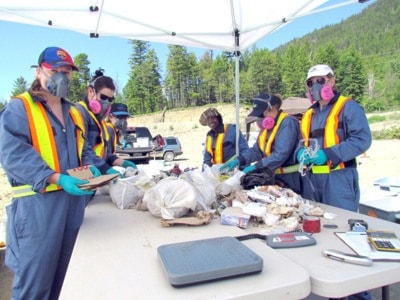At first glance it appeared that the white tent structures recently seen at the Barriere Landfill were set up for vendors, not so, they were there to facilitate a Thompson Nicola Regional District (TNRD) waste composition study.
Marcia Dick, director of ‘Waste Naught’, and her crew of six university students worked at the Landfill for a total of three days from 9 a.m. to 4 p.m., sorting bags of garbage as they were delivered to their work site.
“This is a waste composition study which is essentially a big audit of what is going into the region’s landfills,” said Dick, “The study will be used for planning purposes and for various other inquiries; for instance – how much recyclable materials still end up in general waste at the landfill.”
Dick said she is passionate about waste management, not only in her professional work, but she also has inspired her family and members of the community with her ‘hands on’ approach to waste reduction. She hired the six university students, who all came from different areas, because they all had one thing in common, they are all motivated individuals who are not afraid of getting dirty.
Watching the all female crew in their coveralls and safety face masks as they emptied the garbage bags; it was apparent the job was not only dirty, but had a great deal to do with gross odors and squishy materials.
The students had 130 categories to sort into, and noted it was sometimes nearly impossible to find the correct one.
What are the smelliest items? This seems to be a toss up they said, but pet feces and litter is at the top of the list.
What was the most gross? There was no doubt about that one, all replied in unison “dead rats’.
The students said it’s easy to pick out the bags that come from households with a baby by the number of disposable diapers in them; and also the families who have not yet adopted the ‘Blue Bag’ plan, by the many recyclable items they discard in the landfill.
Dick says the study is taking place at most landfill sites and transfer stations within the TNRD; and the present team will be going to each of them. The study is seasonal, and will be repeated in the fall; however, most members of this team will be returning to universities at that time to continue their studies.
The women, although from different universities and different fields of study made a good team, all interested in the ‘hands on’ education in a field they will not be choosing as a future occupation.
Environmental services manager, for the North Okanagan District, Nicole Kohnert, stopped by at the Barriere Landfill that day to talk ‘shop’ with Dick. Both women are keenly interested in working toward improvements in the area of solid waste management, which was the topic of their conversation.
Dick and Kohnert are previously acquainted, and it seems they will continue to keep in touch and exchange ideas about innovative changes in regard to the future solid waste management.
